Mini reviews
Jukka Sarjala: Kotomaamme outo Suomi [Finland, our strange homeland]
4 April 2013 | Mini reviews, Reviews
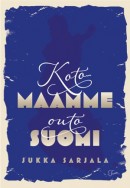 Kotomaamme outo Suomi
Kotomaamme outo Suomi
[Finland, our strange homeland]
Helsinki: Teos, 2013. 264 p.
ISBN 978-951-851-440-7
€ 27, paperback
Jukka Sarjala, ex-director general of the Finnish National Board of Education and bibliophile, is the author of several works of non-fiction, mainly in the field of history. In this book he focuses on the phenomena and events that characterised early twentieth-century Finland, some of them rather peculiar. In a couple of dozen chapters written in a humorous and conversational style the author does not conceal his own opinions, for example, on the foolishness of politicians. Much of the writing is devoted to the era of Finnish independence and the Finnish Civil War, as well as to episodes from political history, such as the story of the attempt to import to the newly independent country a German-born prince as King of Finland, the vagaries of the political far right and far left, the recruitment of Finnish Reds into the British Army – and the horse that gave rise to a small rebel movement. Sarjala draws many fascinating portraits of early twentieth-century figures, for example the utopian socialist Matti Kurikka and the founder of a party that in some ways anticipated the present-day True Finns [Perussuomalaiset], the talkative politician Veikko Vennamo (1913–1997). Although the book lacks footnotes and a bibliography, it demonstrates its author’s extensive reading.
Translated by David McDuff
Johanna Holmström: Asfältsänglar [Asphalt angels]
21 March 2013 | Mini reviews, Reviews
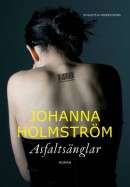 Asfältsänglar
Asfältsänglar
[Asphalt angels]
Helsinki: Schildts & Söderströms, 2012. 294p.
ISBN 978-951-52-3120-8
€29.90, hardback
Finnish translation:
Itämaa
Helsinki: Otava, 2012. 333 p.
Suom. [Translated by] Tuula Kojo
ISBN 978-951-1-26841-3
€29.90, hardback
The immigrant novel has not played a significant role in contemporary Finnish literature; since the wave of Russian refugees in the early 19th century, there have been few immigrants to Finland. In her short story collection Camera Obscura (2009) Johanna Holmström (born 1981) managed to combine realism and fantasy in a fascinating way; her new novel, Asfaltsänglar, is the directly yet eloquently told story of two young immigrant sisters. Leila, bullied at school, is becoming a drop-out, while Samira, who has tried to live according to western norms, lies unconscious after an unexplained accident. Their Finnish mother is a fanatical convert to Islam and their father comes from the Maghreb region. The novel confronts claustrophobic Arabic family culture and western ideals of freedom, taken so far that people completely lose any sense of responsibility for one another, with the adults’ betrayal of their children playing a key role. Holmström goes to great lengths to give a balanced portrayal of both cultures and show why her characters act as they do, even when the results are tragic.
Translated by Claire Dickenson
Maailman paras maa [The best country in the world]
14 March 2013 | Mini reviews, Reviews
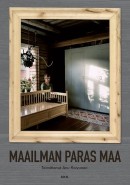 Maailman paras maa
Maailman paras maa
[The best country in the world]
Toim. [Ed. by] Anu Koivunen
Helsinki: Suomalaisen Kirjallisuuden Seura, 2012. 255 p., ill.
ISBN 978-952-222-347-0
€ 37, paperback
In this book twelve writers, representing various fields of research, ponder Finland and Finnishness from the viewpoint of history, ethnology, society, culture and economics. Finland-Swedishness and the relationship between Finns and Russians, the need of Finns to defend their participation in the Second World War in alliance with Germany as a ‘separate war’, and the nostalgia related to lost Karelia. The articles deal with Finland facing economic challenges, attitudes towards foreign beggars and self-critical Finnish opinion pieces. They also take a look at Finnish man as portrayed in the classic novel Seitsemän veljestä (‘The seven brothers’, 1870, by Aleksis Kivi) and in a recent prize-winning film about men talking in the sauna about their feelings, and discuss the relationship of the two national languages, Finnish and Swedish. Well-written and original articles question truisms and challenge the reader contemplate his or her own relationship with Finnishness.
Riku Korhonen: Nuku lähelläni [Sleep close to me]
28 February 2013 | Mini reviews, Reviews
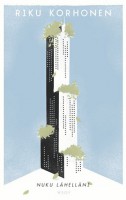 Nuku lähelläni
Nuku lähelläni
[Sleep close to me]
Helsinki: WSOY, 2012. 300 p.
ISBN 978-951-0-39305-5
€29.90, hardback
Contrary to the more agreeable expectations that might be prompted by its title, this book is dominated by the image of a masked anarchist raising his hand in a cloud of teargas. Korhonen (born 1972) is an analyst of social problems who in his most recent novels has expanded his field of vision from the realities of suburban Finland to the global centres of money and power. This novel, his fifth book, offers a pessimistic picture of Europe today. The collapse of the economy has left people with an inner sense of emptiness and anger. A young man travels to a central European financial centre to collect his brother’s corpse. The dead man had a management level job in banking, but his body is discovered with an anti- globalisation protest mask on its face. Analysis of the world situation is combined with elements of a detective thriller. The novel’s love affair is likened to a business deal: capital, profit and risk are equated with desire, hope and sorrow. This anti-capitalist metaphor is a typical theme of contemporary Finnish prose fiction.
Translated by David McDuff
Jörn Donner: Mammuten [The mammoth]
14 February 2013 | Mini reviews, Reviews
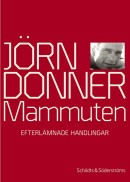 Mammuten. Efterlämnade handlingar
Mammuten. Efterlämnade handlingar
[The mammoth. Leftover business]
Helsinki: Schildts & Söderströms, 2013. 1,128 p., ill.
ISBN 978-951-152-311-54
€37.90, hardback
Finnish translation:
Mammutti. Jälkeenjääneet tekoset
Helsinki: Otava, 2013. 1,087 p., ill.
Suom. [Translated by] Kari Koski
ISBN 978-951-126-311-1
€69,90, hardback
Born in 1933 to a Swedish-speaking family in Helsinki, Jörn Donner, a prominent figure in Finland and Sweden for decades, has published some sixty books. His novel Far och son (‘Father and son’) won him the Finlandia Prize for Fiction in 1985. He has directed and produced films; as a producer he received an Academy Award for Ingmar Bergman’s film Fanny and Alexander. Donner has served two terms in the Finnish Parliament and one in the European Parliament, and represented or supported five different political parties, from the Moscow-loyal Left to the right-wing National Coalition party. Donner’s life has often been the subject of television programmes and he has never passed up the opportunity for more or less well-considered provocations. When he publishes his autobiography at the age of eighty, expectations are high, but Mammuten does not live up to them. It is a sloppy collage of old newspaper articles and introverted diary entries; what emerges is the picture of a man who is disappointed in almost everything he has achieved in life and who sees most of his human relationships as failures. Strangely enough, of the principles that have guided his restless activity and the goals he has striven for in the longer term, Donner writes almost nothing.
Translated by David McDuff
Elina Lappalainen: Syötäväksi kasvatetut. Miten ruokasi eli elämänsä [Bred for the table. How your food lived its life]
8 February 2013 | Mini reviews, Reviews
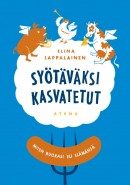 Syötäväksi kasvatetut. Miten ruokasi eli elämänsä
Syötäväksi kasvatetut. Miten ruokasi eli elämänsä
[Bred for the table. How your food lived its life]
Jyväskylä: Atena, 2012. 355 p, ill.
ISBN 978-951-796-843-0
€ 29, paperback
The development of animal welfare depends not only on producers, legislation and control, but also on the preferences of central trading and consumers. In her first book, young journalist Elina Lappalainen describes the conditions in which pigs, cattle and chickens live in Finland before they end up on the table. The living conditions for these are on average better than in many other countries, but they are still often poor. For example, it is difficult to build poultry farms of thousands of chickens, and it matters whether the birds live in cages, are organically grown or a deep litter system is used. Large-scale production does not necessarily mean that pigs, for example, are worse off than they would have been formerly on a small pig farm. On average, the best conditions are provided for cattle, though even most of those spend the long winter in a stanchion barn. Lappalainen has written a thoroughly researched, interesting and balanced review of this internationally important and even emotionally sensitive issue. The book was awarded the prestigious Finlandia Prize for Non-Fiction 2012.
Translated by David McDuff
Osmo Jussila: Neuvostoliiton tragedia. Utopiasta vankileirien saaristoksi [The tragedy of the Soviet Union. From utopia to Gulag Archipelago]
31 January 2013 | Mini reviews, Reviews
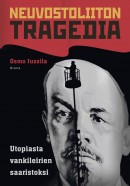 Neuvostoliiton tragedia. Utopiasta vankileirien saaristoksi
Neuvostoliiton tragedia. Utopiasta vankileirien saaristoksi
[The tragedy of the Soviet Union. From utopia to Gulag Archipelago]
Helsinki: Otava, 2012. 448 p., ill.
ISBN 978-951-1-26521-4
€32.80, hardback
The acclaimed Russian and Soviet history scholar Osmo Jussila examines the early history of the Soviet Union from a fresh perspective. He shows how, in the years following the 1917 Revolution, an originally positive idea for a better society turned into a bureaucratic tyranny. The Soviet Union’s strong man V.I. Lenin created the Bolshevist Party as a paramilitary organisation which managed to seize power in October 1917. Even in the early years of Soviet power the ‘Red Terror’ crushed its opponents with executions and the establishment of prison camps. Although Lenin was a good professional revolutionary, he was almost incapable of building a new society: his solutions were often cruel, arbitrary and hasty. Jussila’s general view of Lenin is in line with the ideas that are familiar from more recent historical research, but the author also focuses and deepens his analysis to provide an essentially complete picture of Soviet Russia’s chaotic development and of Lenin’s role in the formation of the oppressive Soviet state.
Translated by David McDuff
Seita Vuorela: Karikko [The reef]
24 January 2013 | Mini reviews, Reviews
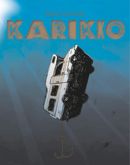 Karikko
Karikko
[The reef]
Kuvitus [Ill. by]: Jani Ikonen
Helsinki: WSOY, 2012. 357 pp., ill.
ISBN 978-951-0-38640-8
€28.90, hardback
Karikko is a self-assured work, aware of its odd charm. It is intended for readers who prefer not to have pre-digested material fed to them; this book has been classified as both a young adult and adult book. Vuorela (née Parkkola) is excellent proof that the global boom in fantasy literature can be harnessed in support of an author’s own artistic ambitions to reinvigorate the genre. She has also crossed a difficult barrier by making it into the American publishing market. Karikko delves into feelings of decay, devastation and abandonment. The text is redolent with the smells of seaweed and mildew; there are textures pockmarked with rust and the melancholy of abandoned homes. At the centre of Karikko is a family with mismatched siblings – 14-year-old Mitja and his elder brother Waldemar – as well as abandonment, sorrow and guilt. Seita Vuorela structures her plot as a mosaic with flashbacks, foreshadowing and random bits. This technique is quite challenging for the reader but ultimately rewarding.
Translated by Ruth Urbom
Mila Teräs & Karoliina Pertamo: Elli ja tuttisuu [Elli and the dummy]
24 January 2013 | Mini reviews, Reviews
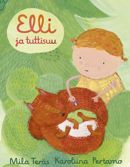 Elli ja tuttisuu
Elli ja tuttisuu
[Elli and the dummy]
Kuvitus [Ill. by]: Karoliina Pertamo
Helsinki: Otava, 2012. 31 pp.
ISBN 978-951-1-26045-5
€16.90, hardback
The new Elli series of picture books continues the tradition in Finnish children’s literature of giving an idyllic portrayal of the natural world: even a small child and her parents have time to marvel at nature together. In reality, more and more children are becoming estranged from their natural surroundings. Elli is an energetic little two-year-old whose mother encourages her to give away her beloved dummy (pacifier) to a young squirrel in the garden. This book tells a typical story about everyday life that will reinforce children’s self-esteem and sense of identity, but fortunately Elli is also allowed to be a little girl who needs looking after by her parents. Our performance-obsessed society expects nearly superhuman effort and skills even from children, so it is important that kids are allowed to be kids – in children’s literature, at least. Karoliina Pertamo’s illustrations glow with warm, invigorating colours. Pertamo (b. 1971) has quickly established a highly individual illustration style for herself.
Translated by Ruth Urbom
Esko-Pekka Tiitinen & Nikolai Tiitinen: Jätti ja jänöset [The giant and the bunnies]
24 January 2013 | Mini reviews, Reviews
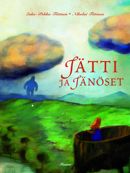 Jätti ja jänöset
Jätti ja jänöset
[The giant and the bunnies]
Kuvitus [Ill. by]: Nikolai Tiitinen.
Helsinki: Tammi, 2012. 25 pp., ill.
ISBN 978-951-31-6573-4
€19.90, hardback
This powerful allegory set in the animal kingdom is a tale of global inequality – with a lovely, take-it-easy, imaginative approach that emphasises tolerance and respect for nature. The rabbit community is shaken up when an arrogant giant barges into their territory. At first, the rabbits try to take an understanding view of the interloper, but he ends up in grave danger as a result of his own actions. Only the actions of the kind-hearted rabbits can save him. The calm tone and engaging pace of Esko-Pekka Tiitinen’s story make it ideal for reading out loud. It has the timeless enchantment of traditional animal fairy tales. The mixed-media illustrations by Esko-Pekka Tiitinen’s son Nikolai radiate warmth and a sense of togetherness, but also power, hatred and estrangement where necessary. The seamlessly integrated text and illustrations create an enjoyable reading and visual experience for children and adults in much the same vein as Herra Kuningas (‘Mister King’, Otava, 1986) by Raija Siekkinen and Hannu Taina, which has already joined the ranks of classic Finnish children’s titles.’
Translated by Ruth Urbom
Christel Rönns: Det vidunderliga ägget [A most extraordinary egg]
24 January 2013 | Mini reviews, Reviews
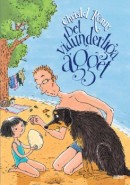 Det vidunderliga ägget
Det vidunderliga ägget
[A most extraordinary egg]
Kuvitus [Ill. by]: Christel Rönns
Helsingfors: Söderströms / Stockholm: Bonnier Carlsen Bokförlag, 2012. 32 p., ill.
ISBN 978-91-638-6857-3
€16.90, hardback
Finnish edition:
Perin erikoinen muna
Suom. [Translated by] Mirjam Ilvas
Helsinki: Tammi, 2012. 30 p., ill.
ISBN 978-951-523-183-3
€15.90, hardback
This is the third work that the graphic designer and illustrator Christel Rönns (born 1960) has written in her own right. With her relaxed and humorous illustration style, Rönns has provided the visual component of some 60 children’s books. This story portrays a family – parents, two little girls and a dog (the author has dedicated her book to the memory of her hovawart dog Freja who died at 14). One summer’s day they find a large egg on the beach and bring it home. But the egg, dropped by accident, reveals a little four-legged creature: named Koi-Koi, it turns out to be delightfully friendly and playful. Nobody actually knows what it is – not even a professor of zoology – but it eats and grows to an enormous size, so the house becomes very cramped (and Koi-Koi’s massive farts send the family running…). But then Koi-Koi begins to disappear at night, and one day he doesn’t come back. Missing a lost pet is a new feeling for the girls (their parents must be secretly relieved, as must the dog!). The story is both funny and gently melancholy, the illustrations detailed and humorous. The book was awarded the Finlandia Junior Prize in 2012.
Sari Peltoniemi: Gattonautti ja muita arkisatuja [The cattonaut and other everyday tales]
24 January 2013 | Mini reviews, Reviews
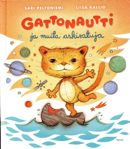 Gattonautti ja muita arkisatuja
Gattonautti ja muita arkisatuja
[The cattonaut and other everyday tales]
Kuvitus [Ill. by]: Liisa Kallio
Helsinki: Tammi, 2012. 67 pp.
ISBN 978-951-31-6576-5
€19.90, hardback
There has been a desperate shortage of short stories and fairy tales for a long time. Now Sari Peltoniemi has bravely risen to this challenge. In her previous young adult novels, she cultivated the ‘new weird’ genre, in which strange and fantastical elements encroach on everyday life. This collection can be categorised as the first Finnish children’s book that makes use of that fantasy subgenre. Peltoniemi’s ten stories also pay homage to traditional Finnish folk tales: a deceased grandfather makes a reappearance to his grandson at midnight; a little sister imagines her teenage sister changing from a fairy into a troll, as in folk tales about changelings. Everyday life is wrenched into strange or absurd situations without warning. Peltoniemi’s portrayals of children display real psychological understanding and insight. The age range for this book, for reading aloud as well as independent reading, extends from preschool to older school-aged children, as the age of the main characters is not emphasised. Liisa Kallio’s child-like, rounded illustration style does indicate, however, that the intended target group is children under 10.
Translated by Ruth Urbom
Sanna Pelliccioni: Onni-poika saa uuden ystävän [Onni gets a new friend]
24 January 2013 | Mini reviews, Reviews
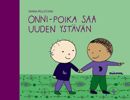 Onni-poika saa uuden ystävän
Onni-poika saa uuden ystävän
[Onni makes a new friend]
Kuvitus [Ill. by]: Sanna Pelliccioni
Helsinki: Minerva, 2012. 32 pp.
ISBN 978-952-492-674-4
€15.90, hardback
The series about a boy named Onni has become a firm favourite among preschool-aged children. Even small children’s picture books are alert to real-life changes in society; in this book – the seventh in the series – Onni gets a new neighbour: a little boy named Aram and Onni quickly become firm friends, even though they do not speak the same language at first. Their friendship across cultural barriers is explained in a straightforward manner that children can grasp. It says something about the introversion of Finnish society and about cultural differences that the friendship is initiated by Aram, who brings some rice pudding made by his mother as a treat for his new neighbours. Pelliccioni’s round-headed figures, characteristic of her style, are suitably simple. She manages to convey fine nuances in their expressions and body language.
Translated by Ruth Urbom
Timo Parvela: Maukka, Väykkä ja Karhu Murhinen [Meowser, Barker and Killington Bear]
24 January 2013 | Mini reviews, Reviews
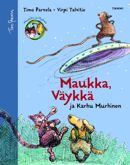 Maukka, Väykkä ja Karhu Murhinen
Maukka, Väykkä ja Karhu Murhinen
[Meowser, Barker and Killington Bear]
Kuvitus [Ill. by]: Virpi Talvitie
Helsinki: Tammi, 2012. 127 pp.
ISBN 978-951-31-6167-5
€20.90, hardback
This novel in the Maukka ja Väykkä series tells about friendship among a cat, a dog and a shrew. There is a need for more children’s books for the whole family that can be read aloud. The award-winning duo behind this title have created a book with brief chapters and an engaging setting. Maukka is an attention-seeking cat with a quick temper, while Väykkä is a laid-back, worldly-wise dog. Their life together seems to be a constant squabble over which one of them is right. The latest arrival in the animal community is a little shrew, who has a heart of pure gold despite his fearsome name. He manages to teach the cat-and-dog duo a few things about life. The shrew’s life span is much shorter than that of the cat and dog; Murhinen himself has a sanguine attitude to the matter and teaches Maukka, Väykkä and the reader a number of important things about life and death.
Translated by Ruth Urbom
Katarina von Numers-Ekman: Singer
24 January 2013 | Mini reviews, Reviews
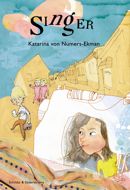 Singer
Singer
Kuvitus [Ill. by]: Jenny Lucander-Holm
Helsinki: Schildts & Söderströms, 2012. 144 pp.
ISBN 978-951-52-3013-3
€17.90, hardback
Singer by Finland-Swedish author Katarina von Numers-Ekman deals with some fairly dark childhood emotions in an intense way, but manages to avoid too much angst. Josefin is an 11-year-old girl who lives alone with her father following the death of her mother. The girl does not dwell daily on the loss of her mum, but as she grows up she finds herself missing her mother more. This novel devotes an unusual amount of space to questions of language and identity through the mother’s British background and the family’s Finland-Swedish heritage. Singer is a clever double reference: Josefin has a Singer brand sewing machine, and the key plot point centres around a singing exam. Josefin goes through a number of embarrassing experiences with her friends. Her feelings of embarrassment or shame are linked with things like poor swimming skills, a classmate’s teasing, or a friend’s grandfather’s alcohol consumption. Katarina von Numers-Ekman manages to infiltrate the world of children’s experiences without making the reader feel like a voyeur. Singer provides numerous points of access to the painful growing-up years of childhood and early adolescence.
Translated by Ruth Urbom
